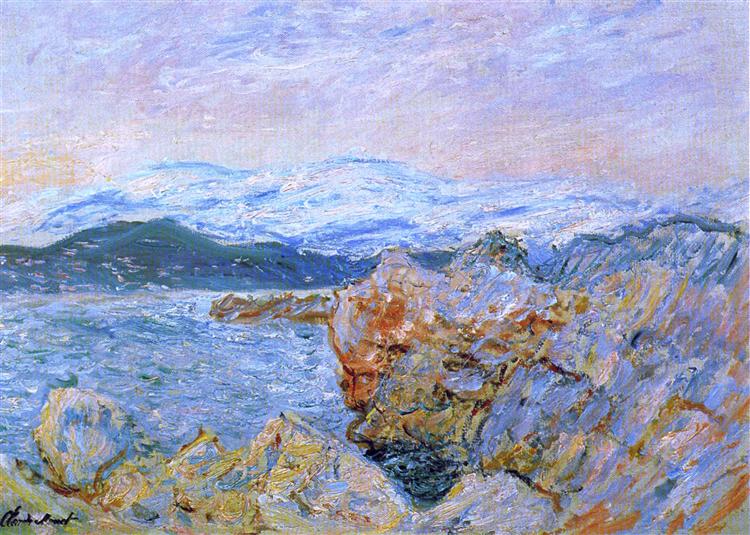Beschreibung
In 1888, Claude Monet painted The Gulf of Juan at Antibes, a work that encapsulates the essence of the French landscape and the artist's innovative approach to capturing light and color. Depicting the bright and vibrant Gulf of Juan on the azure coast of the French Riviera, this painting offers us a magnificent example of the Impressionist style for which Monet became famous. Through careful observation of the ephemeral effects of light on water and land, Monet creates an atmosphere marked by tranquility and a deep connection with nature.
The composition of the work is fundamental to appreciating its visual impact. Monet uses a perspective that invites the viewer to enter the landscape. The horizontality of the horizon, extended along almost the entire piece, suggests the vastness of the sea, while the gentle undulations of the waves add dynamism to the scene. In the background, mountains rise, creating a harmonious contrast with the plane of the water. This focus on the arrangement of elements reveals Monet's ability to guide the viewer's gaze, giving them a sense of immersion in the space depicted.
Color is perhaps the most notable aspect of "Les gulfs du jeunesse au Antibes." Monet employs a rich, luminous palette, where the varying shades of blue in the water play in a constant dialogue with the yellows and greens of the surroundings. The surface of the water, captured with loose, spontaneous brushstrokes, reflects the hues of the sky, suggesting a constant interaction between the water element and its surroundings. This use of color and the technique of rapid, visible brushstrokes are characteristic of Impressionism, which seeks to capture not only form and color, but also the transience of the moment.
In the painting, no human characters are observed, reinforcing the feeling of a pure natural setting, where attention is completely focused on the landscape. This can also be interpreted as Monet's way of emphasizing the beauty of the environment over the human experience, inviting a silent contemplation of nature. However, the subtle presence of a small boat on the water opens a thread of connection between the human being and the natural environment, suggesting a peaceful coexistence.
An interesting aspect of "Le Golfe Jean at Antibes" is the context in which it was created. During the 1880s, Monet was deeply influenced by the landscapes of the South of France, where he found a new light and atmosphere that revitalized his artistic practice. This work is representative of the period when Monet moved to the Riviera, seeking warmer temperatures that would allow him to work outdoors and experiment with light. The search for light and its representation are themes that are not only part of this painting, but of his work in general.
The painting stands alongside other major works of Impressionism, in which Monet, as well as his contemporaries, explored the capture of light and atmosphere in landscapes. Works such as Impression, Sunrise and The Water Lilies Series reflect this focus on the effects of light and color, making The Gulf John at Antibes a piece that embodies and expands on the aesthetic concerns of its time.
In short, "Le Golfe Jean en Antibes" is a work that stands out not only for its visual beauty, but also for the way it reflects the ideals of Impressionism. The masterful use of color, harmonious composition, and meticulous attention to light and environment make this painting a lasting testament to the genius of Claude Monet and his deep connection with nature.
KUADROS ©, a famous painting on your wall.
Hand-made oil painting reproductions, with the quality of professional artists and the distinctive seal of KUADROS ©.
Painting reproduction service with satisfaction guarantee. If you are not completely satisfied with the replica of your painting, we will refund 100% of your money.

